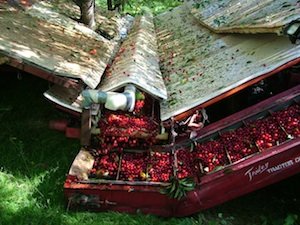Michigan’s domination of the tart cherry crop will return this year.
At the annual Fruit Crop Guesstimate held in Grand Rapids, Michigan, June 19, industry representatives said this year’s crop could be 276 million pounds, coming after a year that saw production fall to less than 75 million pounds.
Normally, Michigan produces more than 70 percent of the nation’s crop. Last year, Utah and Washington became the leading producers as Michigan’s production fell to 11.6 million pounds.
This year, Michigan production was “guesstimated” at 208.5 million pounds, out what is expected to be a national crop of 276 million. Cherry Industry Administrative Board manager Perry Hedin believes the industry can sustain sales of about 260 million pounds a year. The board was to meet the day after the Guesstimate to set a “restriction” percentage that would set aside extra production for sale in short-crop years.
After the very short crop last year, there are about 20 million pounds estimated to be in inventory, so the industry starts this year with virtually a clean slate.
The other major producing states are Utah, with production this year estimated at 25 million (down from 39.9 million last year); Washington, 20 million estimated this year compared to 27 million last year; New York, estimated at 9 million pounds this year compared to only 1.1 million last year; Wisconsin, estimated at 9.5 million pounds compared to only 0.5 million last year; Pennsylvania, pegged at 2.5 million pounds this year, the same as last; and Oregon, 2 million pounds, compared to 2.5 million last year.
About 12 million pounds of tart cherries will be grown in the Canadian province of Ontario this year.
Production in Michigan is concentrated in four counties around the Grand Traverse Bay. That region alone will produce 125 million pounds this year, according to Eric MacLeod at Cherry Growers, Inc.
Phil Korson, president of the Cherry Marketing Institute, said the short crop last year had greatly encouraged imports, which came in mainly from Poland and Turkey. More than 52 million pounds of frozen cherries were imported, and cherry juice concentrate imports soared to a raw equivalent total of 143.8 million pounds.
“Two thousand twelve forever changed our markets,” he said. “It is up to us to recapture them.”
During the social hour after the Guesstimate, growers speculated on how hard that would be. The European cherries are Morello types, sweeter than Montmorency, darker red skinned and dark red flesh, while Montmorency has light skin and clear flesh.
Montmorencies do not bleed when put into baked products. The technology to dry Montmorency cherries does not translate to Morello types, and the juice is also different, so the growers thought users would willingly switch back.
Processing peaches
During the Fruit Crop Guesstimate, individual state figures were not revealed for peaches for processing, which are dominated by California clingstone peaches. U.S. average production the last three years was 516,587 tons. The crop was down last year at 475,110 tons. The Guesstimate for 2013 is 495,000 tons.
The numbers were presented by Leo Steffens, of Peterson Farms, who said the crop was very good across the country but there could be shortages. Cling acreage is declining rapidly in California, he said, and across the country more orchards are being pulled than planted. In the last decade, cling peach acreage in California has fallen from 31,400 acres to 21,500.
Sweet cherries
The nation’s sweet cherry production is dominated by Washington, where 82 percent is sold fresh. Production in Washington this year is estimated at 165,384 tons. Oregon production was put at 56,276 tons.
Michigan’s production mostly goes for processing. The state’s production was put at 34.5 million pounds, of which 2.5 million will be canned, 9 million frozen, 21.5 million brined, and 1.5 million sold fresh.
Blueberries
The Western Hemisphere blueberry crop was estimated at 950 million pounds by John Shelford of Naturipe Foods. Shelford is a long-time industry observer who develops crop size estimates, among other things.
Production is growing at a rate of about 8 percent per year, he said.
Of that total, about 550 million pounds will be highbush blueberries produced in North America, with South America’s growing production adding more than 300 million. The remainder, about 100 million pounds, are lowbush (wild) blueberries, produced in Maine and Canada’s Maritime Provinces.
Production in Michigan was estimated by Michigan grower Bob Carini at 104 million pounds, of which just over half will be sold fresh and the rest (51 million) processed.
Production has been growing fast in the West, especially eastern Washington, Shelford said. The West now contributes 360 million pounds, while the Southeast, mainly Georgia, adds 150 million and the Northeast, mainly New Jersey, 70 million.


Leave A Comment